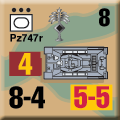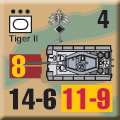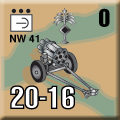| Afrika 1944:
Scenario Preview, Part 3
By Mike Bennighof, Ph.D.
August 2019
 In our last installment, I admitted having broken our own rules with Panzer Grenadier: Afrika 1944, In our last installment, I admitted having broken our own rules with Panzer Grenadier: Afrika 1944,
A long time ago (at least 10 years back, maybe longer), we printed a special sheet of pieces for our Gold Club that included German-made tanks in Italian colors, for Panzer Grenadier. We had a huge number of leftover pieces, because in those days we had to print them in massive press sheets with six or eight different sets at once.
There were 43 Italian pieces on the sheet; one of them was up near the top away from the others, with Soldier Kings pieces we used with The Potato War (because we had them so, why not?). So that one had to be left out (a PzKpfw IIIJ) leaving us with 42 usable pieces. At one point I’d decided to use them with another product that we later cancelled, so I added them to Panzer Grenadier: Afrika 1944. Because that would make it that much cooler and weirder. That also gave a fine excuse to use some of the modern Italian tanks that appear in Africa Orientale Italiana and are never used in the game’s scenarios, because we can.
The up-gunned Italians are the centerpiece of Chapter Three, as the Italian Mechanized Corps rushes into action to stop the Anglo-American advance. Let’s look at the scenarios (which include The Scenario):
Chapter Three
Welcome Back to the Fight
The Royal Italian Army’s XX Mechanized Corps theoretically should have commanded two armored divisions and one of mechanized infantry. When the Allied landings began only one of these formations was present in Morocco, with the 134th “Freccia” Armored Division and 101st “Trieste” Mechanized Infantry Division still in Italy equipping with new tanks and armored personnel carriers.
Ariete attacked alone, but did so fully-equipped with two battalions of modern German-designed tanks and one of new-model Italian tanks, plus another of assault guns. While not fielding the cutting-edge armor of the German divisions, Ariete’s tanks were at least as capable as those of the Allies they met in the foothills of the Atlas Mountains.
Scenario Thirteen
Out of Casablanca
October 1944
 While British troops fought their way up the coastal road to Rabat, the Americans had the task of covering their exposed right flank. That would involve heavy fighting, as almost immediately after landing the lead elements of the crack Italian 132nd “Ariete” Armored Division arrived on the scene. While British troops fought their way up the coastal road to Rabat, the Americans had the task of covering their exposed right flank. That would involve heavy fighting, as almost immediately after landing the lead elements of the crack Italian 132nd “Ariete” Armored Division arrived on the scene.
Conclusion
Though never formally a part of the Afrika Korps, the Ariete Division proved itself every bit the equal of the German divisions deployed in the North African desert, if not their superior. The American divisions landing in Morocco had been mobilized in 1940 or even earlier, and had spent years training and preparing for this campaign. They’d need every bit of that against the elite Italian carristi.
Notes
Recon against recon, but this time on a large battlefield where both sides can zip around seeking advantage. The Italians are trying to scout the terrain, and so the Americans have to stop all that zipping around, chasing their motorcyclists around with their armored cars.
Scenario Fourteen
Patton’s Offensive
October 1944
George S. Patton, commanding the American Third Army landed south of Casablanca, saw an opportunity to push past the British on the coastal road and enter Rabat ahead of them. To make that happen, the Americans would have to fight their way through the Ariete Division’s elite Bersglieri barring the path to the north-east.
Conclusion
The Royal Italian Army had learned how to repel British tank attacks in the Western Desert with a combination of elite infantry and anti-tank guns. The Ariete Division went into combat in Morocco with a great deal of combat experience, and for the most part the weapons needed to execute these tactics. The continued use of the 47mm anti-tank gun represented a weak point in the Italian arsenal, but the excellent Ansaldo 90mm anti-aircraft gun used in a ground role helped compensate for this.
Notes
It’s an American armored assault against an Italian infantry defense, except the infantry are Bersaglieri and their anti-tank guns are monstrous 90mm weapons. The Americans have airplanes and lots of big guns to support them, but it’s still going to be a tough day for Old Ironsides.
Scenario Fifteen
Attacco di carri armati
October 1944
 As soon as the Ariete Division assembled its full force, the Italian First Army command hurled it against the advancing Americans. The division had been equipped with the best vehicles Italian industry could provide, including both licensed versions of German-designed tanks and some re-conditioned veterans of German service. As soon as the Ariete Division assembled its full force, the Italian First Army command hurled it against the advancing Americans. The division had been equipped with the best vehicles Italian industry could provide, including both licensed versions of German-designed tanks and some re-conditioned veterans of German service.
Conclusion
Unlike the massive vehicles of the Afrika Korps’ panzer divisions, the Italian tanks had only a slightly margin of superiority over the American Shermans. But that was enough to blunt the American offensive, at least for the moment. The relentless American advance would continue as new men and machines replaced those lost, but the Italians would have no such reinforcement.
Notes
We have a large-scale meeting engagement, with the Ariete Division wielding all of its licensed Panzer IIIJ and IVH tanks, plus some Italian-designed P26 heavy tanks against a huge hoardof Shermans. It’s a mighty clash of iron amid the hills of Morocco.
Scenario Sixteen
Nighttime Jitters
October 1944
 American airpower and artillery made an enormous impression on the Italian division’s command; their infantry and armor, not so much. Italian patrols soon reported a marked dislike for the darkness on the part of the Americans. The Italian Mechanized Corps’ command decided to take advantage of this information, and ordered a night assault on the Americans when their air power could not be brought to bear. American airpower and artillery made an enormous impression on the Italian division’s command; their infantry and armor, not so much. Italian patrols soon reported a marked dislike for the darkness on the part of the Americans. The Italian Mechanized Corps’ command decided to take advantage of this information, and ordered a night assault on the Americans when their air power could not be brought to bear.
Conclusion
As the Italians expected, the Americans did not expect a counter-attack in the darkness, and the Ariete’s tank-supported Bersaglieri pushed their enemies off the targeted heights. The American Shermans were roughly equal to the Italian P26, though much faster, but they had no answer to the deadly Italian 90mm anti-aircraft guns.
Notes
The Americans aren’t totally taken by surprise, and are able to fight back as the Italians make a tank-supported nighttime assault on prepared positions. The mobile Italian 90mm is a deadly weapon even in reduced visibility.
Scenario Seventeen
Ironsides and Ariete
October 1944
With their tank battalions replenished, 1st Armored Division set out on a set-piece attack to clear the way to the town of Rommani directly south of Rabat. The forested hills gave the Italians good cover, and the rough ground would make it very difficult for the Americans to eject the defenders. But Old Ironsides brought plenty of iron.
Conclusion
The Americans got over the river, but the Italians held on to the high ground behind the river and denied the Americans their objectives. A single platoon of monstrous Italian tanks shot up dozens of Shermans attempting to approach the river line. The 1st Armored Division made more progress in the following week as Ariete left their front for a new mission.
Notes
The Americans are trying to force a river line with plentiful Sherman tanks and heavy allotments of artillery and air support. The Italians have a cave troll: the P70/44, known to the Germans as the Royal Tiger. And sunlight won’t make it go away.
Scenario Eighteen
The Mother of All Battles
October 1944
 As the Spearhead Division drove into the foothills of the Atlas Mountains on its way to Meknes, the Afrika Korps’s 15th Panzer Division came forward to stop them. The Axis command had already summoned the Italian 132nd “Ariete” Armored Division to turn south-east and join in the defense against the American tanks. A large tank battle resulted. As the Spearhead Division drove into the foothills of the Atlas Mountains on its way to Meknes, the Afrika Korps’s 15th Panzer Division came forward to stop them. The Axis command had already summoned the Italian 132nd “Ariete” Armored Division to turn south-east and join in the defense against the American tanks. A large tank battle resulted.
Conclusion
Hundreds of burning wrecks marked the battlefield, and as the sun settled into the Atlantic Ocean the Spearhead Division’s assault had been blunted despite the aid of a British tank brigade. The Axis brought both numbers and tank quality to the battlefield, and that resulted in a crushing defeat for the Americans’ best armored formation. The struggle for Morocco would not be resolved easily.
Notes
And this is it: The Mother of All Scenarios. Two Axis armored divisions against an American armored division and a British armoured brigade, brawling across twelve (12!) mapboards. Is it finely balanced for tournament play? Who the hell knows? Who the hell cares? This thing was damned fun to play. It’s what real men and real women play while they drink real beer.
And that’s Chapter Three, which winds up with a Battle Game. Next, we’ll look at . . . Chapter Four.
Click right here to order Afrika 1944 right now.
Sign up for our newsletter right here. Your info will never be sold or transferred; we'll just use it to update you on new games and new offers.
Mike Bennighof is president of Avalanche Press and holds a doctorate in history from Emory University. A Fulbright Scholar and award-winning journalist, he has published over 100 books, games and articles on historical subjects.
He lives in Birmingham, Alabama with his wife, three children and his dog, Leopold. Leopold is currently in print.
|
